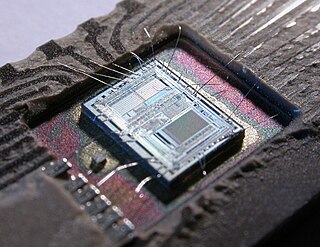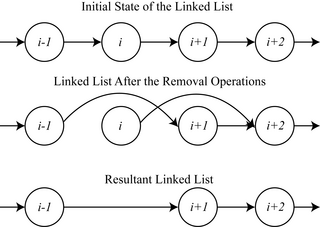In computing, a context switch is the process of storing the state of a process or thread, so that it can be restored and resume execution at a later point. This allows multiple processes to share a single central processing unit (CPU), and is an essential feature of a multitasking operating system.
Forth is a procedural, stack-oriented programming language and interactive environment designed by Charles H. "Chuck" Moore and first used by other programmers in 1970. Although not an acronym, the language's name in its early years was often spelled in all capital letters as FORTH, but Forth is more common now.

A microcontroller is a small computer on a single metal-oxide-semiconductor (MOS) integrated circuit (IC) chip. A microcontroller contains one or more CPUs along with memory and programmable input/output peripherals. Program memory in the form of ferroelectric RAM, NOR flash or OTP ROM is also often included on chip, as well as a small amount of RAM. Microcontrollers are designed for embedded applications, in contrast to the microprocessors used in personal computers or other general purpose applications consisting of various discrete chips.
A real-time operating system (RTOS) is an operating system (OS) for real-time applications that processes data and events that have critically defined time constraints. An RTOS is distinct from a time sharing operating system, such as Unix, which manages the sharing of system resources with a scheduler, data buffers, or fixed task prioritization in a multitasking or multiprogramming environment. Processing time requirements need to be fully understood and bound rather than just kept as a minimum. All processing must occur within the defined constraints. Real-time operating systems are event-driven and preemptive, meaning the OS is capable of monitoring the relevant priority of competing tasks, and make changes to the task priority. Event-driven systems switch between tasks based on their priorities, while time-sharing systems switch the task based on clock interrupts.

In computer science, mutual exclusion is a property of concurrency control, which is instituted for the purpose of preventing race conditions. It is the requirement that one thread of execution never enters a critical section while a concurrent thread of execution is already accessing critical section, which refers to an interval of time during which a thread of execution accesses a shared resource, such as [Shared data objects, shared resources, shared memory].

In computing, booting is the process of starting a computer as initiated via hardware such as a button or by a software command. After it is switched on, a computer's central processing unit (CPU) has no software in its main memory, so some process must load software into memory before it can be executed. This may be done by hardware or firmware in the CPU, or by a separate processor in the computer system.

In computing, a process is the instance of a computer program that is being executed by one or many threads. It contains the program code and its activity. Depending on the operating system (OS), a process may be made up of multiple threads of execution that execute instructions concurrently.

In computer science, a thread of execution is the smallest sequence of programmed instructions that can be managed independently by a scheduler, which is typically a part of the operating system. The implementation of threads and processes differs between operating systems, but in most cases a thread is a component of a process. The multiple threads of a given process may be executed concurrently, sharing resources such as memory, while different processes do not share these resources. In particular, the threads of a process share its executable code and the values of its dynamically allocated variables and non-thread-local global variables at any given time.

The MSP430 is a mixed-signal microcontroller family from Texas Instruments, first introduced on 14 February 1992. Built around a 16-bit CPU, the MSP430 is designed for low cost and, specifically, low power consumption embedded applications.
In concurrent programming, concurrent accesses to shared resources can lead to unexpected or erroneous behavior, so parts of the program where the shared resource is accessed need to be protected in ways that avoid the concurrent access. This protected section is the critical section or critical region. It cannot be executed by more than one process at a time. Typically, the critical section accesses a shared resource, such as a data structure, a peripheral device, or a network connection, that would not operate correctly in the context of multiple concurrent accesses.
In computer systems programming, an interrupt handler, also known as an interrupt service routine or ISR, is a special block of code associated with a specific interrupt condition. Interrupt handlers are initiated by hardware interrupts, software interrupt instructions, or software exceptions, and are used for implementing device drivers or transitions between protected modes of operation, such as system calls.
Micro-Controller Operating Systems is a real-time operating system (RTOS) designed by Jean J. Labrosse in 1991. It is a priority-based preemptive real-time kernel for microprocessors, written mostly in the programming language C. It is intended for use in embedded systems.
In concurrent programming, a monitor is a synchronization construct that allows threads to have both mutual exclusion and the ability to wait (block) for a certain condition to become false. Monitors also have a mechanism for signaling other threads that their condition has been met. A monitor consists of a mutex (lock) object and condition variables. A condition variable essentially is a container of threads that are waiting for a certain condition. Monitors provide a mechanism for threads to temporarily give up exclusive access in order to wait for some condition to be met, before regaining exclusive access and resuming their task.

FreeRTOS is a real-time operating system kernel for embedded devices that has been ported to 35 microcontroller platforms. It is distributed under the MIT License.
Azure RTOS ThreadX is a highly deterministic, embedded real-time operating system (RTOS) programmed mostly in the language C.
RS08 is a family of 8-bit microcontrollers by NXP Semiconductors. Originally released by Freescale in 2006, the RS08 architecture is a reduced-resource version of the Freescale MC68HCS08 central processing unit (CPU), a member of the 6800 microprocessor family. It has been implemented in several microcontroller devices for embedded systems.
In computer science, synchronization refers to one of two distinct but related concepts: synchronization of processes, and synchronization of data. Process synchronization refers to the idea that multiple processes are to join up or handshake at a certain point, in order to reach an agreement or commit to a certain sequence of action. Data synchronization refers to the idea of keeping multiple copies of a dataset in coherence with one another, or to maintain data integrity. Process synchronization primitives are commonly used to implement data synchronization.

ChibiOS/RT is a compact and fast real-time operating system supporting multiple architectures and released under a mix of the GNU General Public License version 3 (GPL3) and the Apache License 2.0. It is developed by Giovanni Di Sirio.
FunkOS is a real-time operating system (RTOS) developed by Funkenstein Software Consulting, targeting a variety of microcontroller architectures. It is free to use in any project - commercial or otherwise - with few conditions. If the kernel is ported to a new target, that code must also be made available for inclusion in future releases. Also, if used in commercial projects, an attribution statement must be included in some form of product documentation.
The MSP432 is a mixed-signal microcontroller family from Texas Instruments. It is based on a 32-bit ARM Cortex-M4F CPU, and extends their 16-bit MSP430 line, with a larger address space for code and data, and faster integer and floating point calculation than the MSP430. Like the MSP430, it has a number of built-in peripheral devices, and is designed for low power requirements. In 2021, TI confirmed that the MSP432 has been discontinued and "there will be no new MSP432 products".







